2025 Complete Guide to Solar Blanket for Pool: Heat Retention, Water Saving, Electricity Cost Reduction – Easy to Use for Beginners
As a core high-efficiency solution for home pool management in 2025, installing a solar blanket for pool is a zero-hassle option for homeowners looking to boost their pool’s functionality. This tool requires no complicated setup while precisely meeting three core needs: heat retention, water saving, and electricity cost reduction. Even beginners new to pool maintenance can quickly recognize the value of a quality solar cover for swimming pool—it works right out of the box, no professional installation needed.
For households that already use a solar blanket for pool, this accessory is an absolute must-have: especially on cold or windy days, a pool loses heat twice as fast as usual (without a cover, the water temperature can drop by 3–5°C in a single day). A well-designed solar cover for swimming pool acts like a “thermal wrap” to lock in heat, preventing sudden temperature drops that ruin swimming plans. Its practicality is also backed by authoritative data from Australia’s Department of Industry, Science and Resources: a standard solar blanket for pool can reduce water evaporation by up to 95%. For a typical 50-square-meter home pool, this translates to saving nearly 3,000 liters of water annually. To help you choose and use the right solar blanket for pool in 2025, this guide will not only curate 5 popular products but also share easy-to-implement energy-saving tips for beginners.
How a Solar Blanket for Pool Works
The core value of a pool solar blanket lies in “achieving multiple energy-saving effects with a simple structure.” Its working principle can be broken down into two aspects: “core heat retention mechanism” and “additional practical advantages”:
1. Core Heat Retention Principle: Trapping Solar Heat with “Bubble Structure + Greenhouse Effect”
A pool solar blanket is not just a regular plastic sheet. It is made of durable polyethylene (PE) or PVC (two common high-wear materials for pool covers), covered with dense “tiny sealed air bubbles”—this structure is the key to its efficient heat retention:
Bubbles capture and transfer heat: The air inside the bubbles efficiently absorbs heat from solar radiation, while the bubble walls slowly transfer this heat to the pool water below. Compared to an uncovered pool, this “bubble insulation layer” boosts solar heat utilization by over 40%, preventing heat from escaping directly into the air;
Simulating the “greenhouse effect” to reduce heat loss: When the blanket covers the pool surface, it forms a “sealed air layer”—just like the glass of a greenhouse. It allows sunlight to penetrate the water while blocking pool heat from escaping via evaporation or air convection. Data shows this mechanism can keep pool water 5-8°C warmer than an uncovered pool, and the heat can last for over 12 hours—ideal for areas with large day-night temperature differences.
2. Additional Advantages: Cutting Chemical Use + Minimizing Evaporation to Reduce Hidden Costs
Beyond its core heat retention function, the solar blanket’s design also solves two major pool maintenance pain points, helping users save on hidden expenses:
Slowing chlorine loss to reduce chemical costs: Chlorine in pools decomposes rapidly under UV radiation (losing 30%-50% in a single day during hot weather), forcing users to frequently replenish chlorine. A pool solar blanket blocks about 90% of direct UV rays from reaching the water, doubling chlorine’s “effective lifespan.” This cuts monthly chlorine costs by 30%, with even more obvious results in high-sunlight regions like Australia or the southern U.S.;
Reducing water evaporation to avoid frequent refilling: An uncovered pool loses 1-2 cm of water depth daily (around 100-200 liters per 10㎡ of pool area). However, according to data from Australia’s Department of Industry, Science and Resources, a pool solar blanket can reduce evaporation by over 95%. This means two things: first, you skip frequent refilling (saving water bills and time); second, it prevents “increased water concentration” caused by evaporation—reducing the hassle of diluting pool water and further lowering chemical use.
3. User-Friendly Design: “Automatic Operation” Even When Unattended
Another advantage of its working principle is that it “requires no manual intervention”: once the blanket is laid, it works 24/7 without power or adjustments. It absorbs solar heat to retain warmth during the day and uses the bubble layer to reduce heat loss at night. Even if you’re away on vacation, it prevents issues like “sudden water temperature drops,” “exhausted chemicals,” or “insufficient water” from unattended maintenance—truly a “self-operating energy-saving steward” for your pool.
The 5 Best Swimming Pool Solar Covers of 2025
Choosing the right swimming pool solar blanket boils down to durability, heat retention, fit, and practicality—and these 5 picks stand out for 2025, each tailored to different pool types and user needs.
Below’s a detailed breakdown of their key strengths:
1. Abimars 16 Mil Solar Pool Cover
Built for long-lasting performance and maximum heat retention, this 16-mil cover is a top choice for homeowners looking to extend their swimming season.
UV & Chlorine Resistance: Infused with 5% UV protectant and 3% HALS stabilizers, it delivers UPF 50+ protection—shielding the cover from sun damage and fading, while also slowing chlorine breakdown (a major win for reducing chemical refills).
Superior Heat Trapping: Thicker than standard 12-mil covers, its dense bubbles act like “mini solar panels” to capture sunlight. It retains heat 30% better than thinner options, keeping pools warm even on cool nights and boosting water temperatures by 8–15°F.
Snug, Flat Fit: Made from heavy-duty 16-mil polyethylene, it lies flatter on in-ground pools (no air pockets, thanks to 9mm bubbles) and resists edge curling. This tight seal locks in heat and cuts water evaporation by up to 97%.
Customizable Without Curling: Unlike thin 12-mil covers that warp after trimming, it maintains its shape even when cut to fit irregular pool shapes (round, kidney, square). It also blocks leaves and dust, keeping water cleaner.
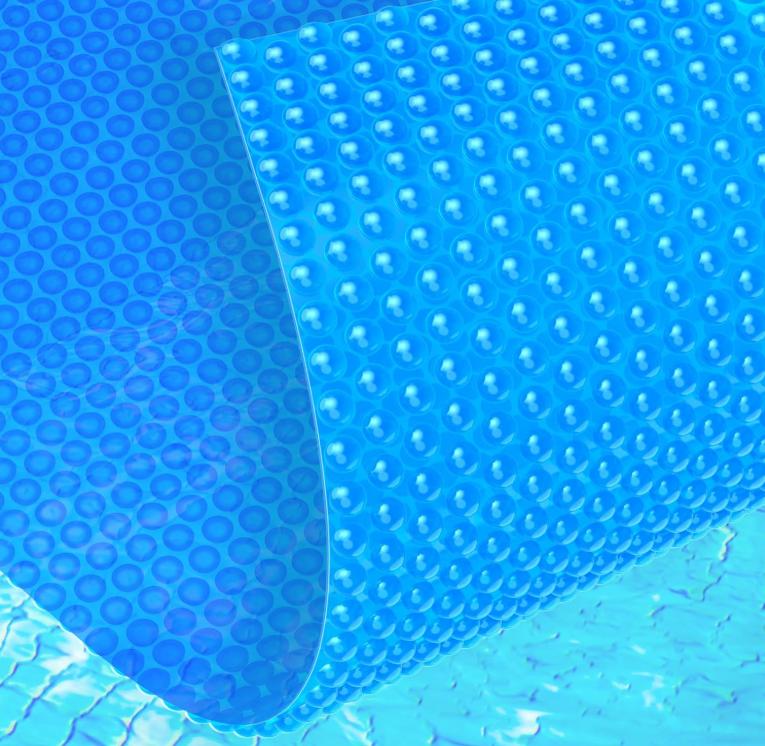

2. SunHeater Pool Solar Blanket
A user-friendly option for above-ground and in-ground pools, this blue pool solar blanket prioritizes ease of use and water savings.
Natural Solar Heating: Designed with bubbles that face down (toward the water), it traps solar warmth and transfers it directly to the pool—no electricity needed for heating.
Minimize Water Refills: Cuts evaporation by up to 95%, meaning you’ll add water far less often (a big cost-saver, especially in dry climates).
Less Cleaning, More Swimming: Acts as a barrier against leaves, dirt, and debris, reducing time spent skimming and lowering the need for cleaning products.
Flexible Sizing: Comes in a 16x32-foot sheet, ideal for rectangular pools, but trims easily to fit square, round, or kidney-shaped designs.
Compact Storage: Despite its large size, the 12-mil material folds down small—store it in a shed or on a shelf when not in use, no bulky storage needed.
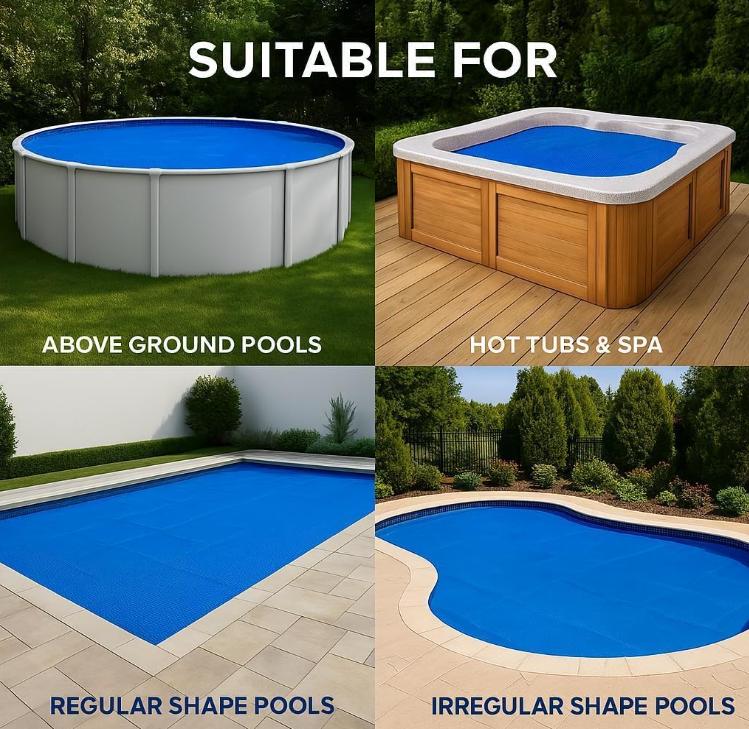

3. TONTAIN US Pool Cover 6FT
Perfect for small, round pools, this 16-mil cover balances heat absorption and hassle-free maintenance.
Patented Heat-Capturing Design: At 16-mil (400μm) thick, its unique pattern absorbs more sunlight, speeding up water warming and locking in heat longer. Bubbles enhance heat transfer from sunlight to water, keeping temperatures consistent.
95% Evaporation Reduction: Covers the pool tightly to minimize water loss, so you’ll refill less frequently and conserve resources.
Easy Trimming & PE Durability: Made from tough PE material (waterproof and sun-resistant, reusable for years) and fits round pools by default. For irregular shapes, simply cut it with scissors—far easier to handle than bulky foam covers.
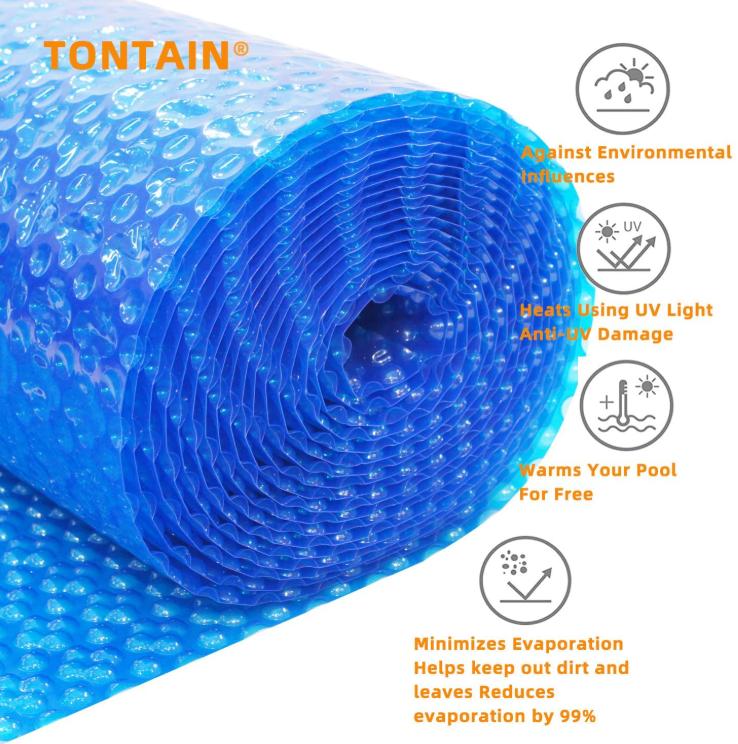

4. VEVOR Solar Pool Cover
A heavy-duty option for both residential and light commercial use, this 16-mil cover excels in harsh sun and high-use pools.
Sun & Tear Resistant: Crafted from durable 16-mil PE, it has strong tensile and tear resistance—no fading or warping, even under intense sunlight. For best longevity, use it in pools with chlorine levels ≤2.5 ppm and pH ≥7.2.
Water & Heat Savings: Closed-bubble design cuts evaporation by 95%, while the thick PE material insulates water to reduce heat loss. It can raise water temperatures by 8–15°C (depending on weather), extending the swimming season and slashing heating costs.
Low-Maintenance: Blocks leaves and dust, so you’ll spend less time cleaning the pool and more time using it.
Universal Fit: Trims easily to match any pool shape (home pools, commercial spas) and size, ensuring full coverage.
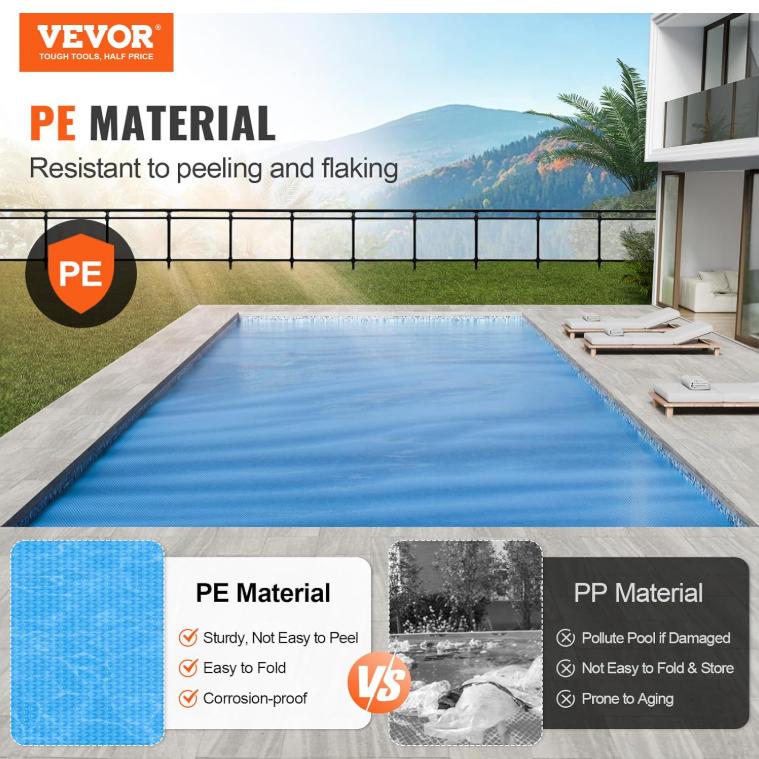

5. VINGLI 12Mil Solar Pool Cover
A budget-friendly yet reliable choice for casual pool owners, this 12-mil cover focuses on simplicity and basic efficiency.
Extend Swimming Hours: Transparent blue material uses thousands of bubbles to absorb sunlight during the day and release heat into the pool at night, lengthening usable swimming time. Note: Bubbles may appear slightly deflated before sun exposure (due to thermal expansion/contraction)—this is normal.
Water Conservation: Reduces maximum water evaporation, making it an eco-friendly choice for homeowners looking to cut water bills.
Easy Installation & Cleaning: Simply lay it over the pool (match to your pool size) to block leaves and debris—no tools needed. Keeps water cleaner with minimal effort.
Customizable Size: Comes with 2 inches of extra material to fit all pool shapes. Trim it with scissors for irregular designs (oval, free-form) in minutes.
Durable & Reusable: Heavy-duty material with welded seams for long-term use. Pair it with VINGLI’s pool cover reel (sold separately) for easier putting on/taking off.
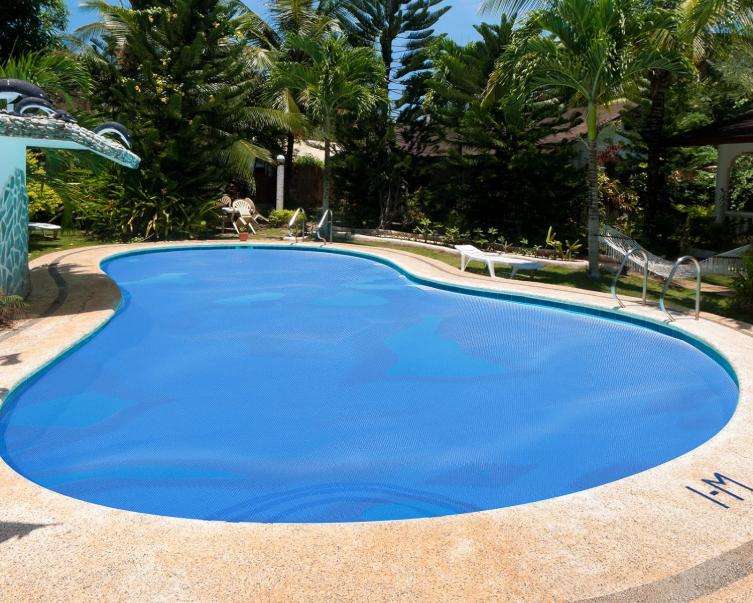

Complete Guide to Using & Storing a Solar Cover for Swimming Pool
80% of a pool solar blanket’s performance and lifespan depends on proper use and scientific storage. Improper practices—such as laying it upside down or folding it when damp—will not only reduce its heat retention and water-saving effectiveness but also cause the cover to crack or develop mildew. Below are practical, scenario-based tips for using and storing your solar cover, even beginners can master them easily:
Usage Tips: 3 Steps to Lay It Right + 4 Details to Maximize Energy Savings
Before Laying: Prepare Properly to Avoid Cover Damage
Clean the pool first: Use a pool skimmer to remove leaves, pebbles, and other debris from the water surface before laying the cover. If there are sharp objects at the bottom (e.g., broken pool brush parts), clear them in advance—debris can puncture the cover’s bubble layer, reducing heat retention and even shortening its lifespan.
Distinguish between “front and back” – don’t lay it upside down!
A solar cover has a bubble side and a smooth side—90% of beginners mix them up:
Correct way: Bubble side down (touching the water), smooth side up. The bubble layer acts like “mini solar panels” to trap heat and transfer it to the water, while the smooth side reflects UV rays to slow the cover’s own aging.
Wrong way: Laying the bubble side up causes heat loss, and bubbles are more likely to collect dust or get torn by wind.
Pre-adjust for your pool shape: If the cover is cut to fit an irregular pool (e.g., kidney-shaped or round), align it with the pool edges first, then smooth it toward the center. Avoid stretching the cover (especially 12-16 mil thin models), as excessive pulling can crack the edges.
During Use: 3 Key Practices to Maintain Energy Savings
Secure the edges to resist wind displacement: On windy days, outdoor pool covers are prone to being blown up or wrinkled. Pair the cover with pool cover anchor ropes or edge weights (available on Amazon or at pool supply stores): Press the weights along the pool edges to hold the cover in place, or thread anchor ropes through the cover’s pre-drilled holes (available on some models) and tie them to pool handrails. This prevents displacement, which would increase water evaporation.
Lift the cover regularly for ventilation to balance water quality: Long-term coverage can reduce oxygen levels in the pool water. Lift the cover for 1-2 hours daily (e.g., 9-10 AM when sunlight is mild) to let the water contact air—this prevents algae growth. Especially in hot summer, poor ventilation may even speed up chlorine consumption.
Clean the cover surface promptly to avoid blocking heat absorption: After rain or when there’s a lot of debris, use a soft-bristle brush (e.g., a car wash brush) to gently sweep dust and leaves off the smooth side—debris blocks sunlight and reduces heat absorption. If the cover gets oil stains (e.g., lubricant from pool toys), wipe it gently with water and neutral dish soap. Never use a hard brush or bleach (they corrode PE material).
Special Weather: Adjust Flexibly to Protect the Cover
Heavy rain/hail: Temporarily store the cover: Heavy rain adds weight to the cover, causing it to stretch and deform; hail can puncture the bubble layer. Store the cover in advance when such weather is expected, and re-lay it once the weather clears.
Low winter temperatures: Avoid snow accumulation on short-term covers: If you still need to cover the pool briefly in winter (e.g., to keep leaves out), clear snow from the cover promptly—melted snow seeps into the cover’s fibers, and freezing in low temperatures will crack the bubble layer. It’s recommended to use a “winter pool cover” over the solar cover, with the solar cover as an inner insulation layer.
Storage Tips: Classify by “Short-Term/Long-Term” to Avoid Mildew & Cracking
Short-Term Storage (1-7 days of non-use, e.g., weekend trips): Convenient & Space-Saving
Manual folding method (for small pools under 10 square meters):
Fold the cover from the pool edge toward the center, ensuring the bubble sides touch each other (to avoid the smooth side rubbing against bubbles).
Then roll it into a cylinder 20-30 cm in diameter along the long side (rolling it too tightly will damage the bubbles), and secure it with 2-3 loops of rope in the middle.
Store it in a breathable storage box by the pool (not airtight) to avoid direct sunlight (UV rays accelerate aging).
Reel storage method (for large pools over 10 square meters):
Pair with a swimming pool solar cover reel (manual or electric) to increase storage efficiency by 50%:
Thread the reel rod through the pre-drilled holes on one side of the cover (for models without holes, first fix the cover edge to the reel).
Crank the handle manually (or press the button for electric reels) to wind the cover evenly around the reel—avoid pulling during the process.
Lean the rolled reel against the poolside wall or hang it on a dedicated hook (saves floor space and ensures good ventilation).
Long-Term Storage (1 month+ of non-use, e.g., winter pool shutdown): Thorough Maintenance for Next-Year Use
Step 1: Clean & dry to prevent mildew:
Lay the cover on a flat surface (e.g., a concrete floor covered with an old towel to prevent scratching), rinse both sides with water to remove residual chlorine and algae.
Wipe the surface dry with a soft cloth, or air-dry it in a cool, ventilated area (avoid direct sunlight, which makes the cover brittle) until its weight returns to 80% of its new state (about 10% moisture content—no dampness when touched).
If there are local mildew spots (usually caused by folding when damp), wipe them with a mixture of water and white vinegar (10:1 ratio), then air-dry before storage (do not use alcohol or disinfectants—they corrode the material).
Step 2: Fold/wind correctly to avoid crushing:
Folded models: Roll into a cylinder as in “short-term storage,” then cover with a breathable dust bag (e.g., a bag cut from an old sheet)—do not use airtight plastic bags (they trap moisture).
Reel models: Wrap the wound cover with a soft cloth, then put on a dust bag to prevent the reel’s metal parts from scratching the cover.
Step 3: Choose the right storage environment – keep away from 3 “hazards”:
Avoid sharp objects: Do not store the cover near pool tools (e.g., pool brushes, vacuum cleaners) to prevent punctures from metal parts.
Avoid high temperature/moisture: Do not store it in a garage corner (prone to dampness) or a sun-exposed balcony (high temperatures age PE material). The best location is a cool, dry storage room (10-25℃, humidity below 50%).
Avoid heavy pressure: Do not stack items (e.g., laundry detergent, toolboxes) on the stored cover—this collapses the bubble layer and reduces heat retention in future use.
Pitfall Avoidance Guide: 3 Common Mistakes 90% of People Make
Mistake 1: Folding immediately after sun exposure – On hot summer days, the cover can reach over 40℃ after sun exposure. Folding it immediately traps heat in the bubble layer, accelerating material aging. Let it cool for 1 hour before storage.
Mistake 2: Folding when damp without drying – This is the main cause of mildew. Even if the surface seems dry, moisture may remain in the bubble gaps. Long-term storage will lead to mildew, discoloration, and odor.
Mistake 3: Pulling hard to remove the cover – Some users yank the cover from one side of the pool, which easily tears the edges. The correct way is to gather the cover from both ends toward the center, or use a reel for assistance.
By following these tips, you can not only keep your solar cover for pool at its best (maintaining over 90% of its original heat retention efficiency) but also extend its lifespan from 2-3 years to 5+ years—saving you the cost of replacement indirectly.
Australian Residential Pools: Analysis of High Energy Consumption & Localized Energy-Saving + Emergency Solutions
In Australia, a swimming pool is a core leisure facility for households (around 30% of households own a private pool). Yet due to hot summers (which require constant cooling and water circulation), mild winters (when heating is needed in some regions), and regional differences in electricity tariffs, its energy consumption accounts for 18%-28% of a household’s total energy use—making it a veritable "high-energy-consuming unit."
1. Core Energy-Consuming Systems of Pools:
Pool Cleaner
Dry dust in Western Australia and South Australia, fallen leaves on the east coast during summer, and algae growth fueled by high temperatures make pool cleaners essential for most 10–25㎡ residential pools. Energy consumption varies drastically by cleaner type, directly impacting total pool energy use:
Pool Cleaner Type | Power Range | Operation Dependency | Energy Traits (for a 20㎡ pool) | Adoption Rate Among Australian Households |
Robotic Pool Cleaner | 50–150W | Independent battery/power | Runs 2–3 times weekly, 2 hours per session; at AUD 0.3 per kWh, single-use energy cost is AUD 0.03–0.09, with annual energy cost around AUD 26–78 | 65% (high convenience, labor-saving) |
Pressure-Side Pool Cleaner | No independent power | Relies on pool pump | Must operate in sync with the pool pump, increasing pump load by 15–20% (e.g., a 1.5HP pump rises from 1100W to 1265W), indirectly driving up pump electricity costs | 20% (low initial cost) |
Suction-Side Pool Cleaner | No independent power | Relies on pump suction | Also increases pump load; prone to filter clogging (requires frequent cleaning) and low efficiency, so it is gradually being phased out | 15% (leftover from older pools) |
Key Energy Note: While robotic cleaners have independent energy use, they prevent the pool pump from "overworking." In contrast, pressure-side cleaners seem to have "zero independent energy consumption" but add AUD 120–180 to annual water circulation system costs—making them a more hidden waste.
Air-Source Pool Heat Pump
Tropical regions like Queensland and the Northern Territory require no heating year-round. However, in temperate areas (southern NSW, Victoria, South Australia), water temperatures need to be maintained at 24–26°C (comfortable swimming temperature) during winter (June–August), making heat pumps the core heating equipment. Some households also use them for auxiliary cooling in summer (to keep water temperature below 28°C).
Energy Traits:
Energy Efficiency: 70% more efficient than traditional electric heaters (must use models meeting Australian standard AS/NZS 3666.2, with a COP of 3.2–5.5), but winter operation is intensive;
Actual Cost: A 20㎡ pool runs 6–8 hours daily in winter, consuming 8–12 kWh and costing AUD 2.4–3.6 per day. This accounts for 50–60% of total pool energy use (summer energy consumption is only 1/3 of winter’s).
Pool Pump
Australia’s summer heat accelerates microbial growth, requiring frequent water circulation. Additionally, 80% of households use a Salt Chlorinator, which needs the pump to run continuously to stabilize chlorine levels—making the pump a "non-stop high-energy device."
Energy Pain Points:
Traditional Fixed-Speed Pumps (1.5–2.0HP, 1100–1500W): Operating 8 hours daily (common in Australian households), they consume 8.8–12 kWh per day, costing AUD 2.6–3.6. Annual energy costs exceed AUD 1,000, accounting for 35–45% of total pool energy use;
Policy Note: ACT and Victoria have explicitly banned fixed-speed pumps from 2025 onwards, making variable-speed upgrades inevitable.
Electric Solar Cover Reel
Australia’s UV index is consistently above 5, and intense ultraviolet radiation accelerates solar cover aging. Strong summer winds (e.g., in Sydney, Brisbane) make manual storage difficult, so electric reels have an adoption rate of over 70%.
Energy Traits: 50–100W power, consuming 0.05–0.1 kWh per retraction (costing AUD 0.015–0.03). With daily retraction, annual energy use is 18–36 kWh, accounting for only 2–3% of total energy consumption—classifying it as a "low-energy but high-frequency use" device.
2. Energy-Saving Solutions:
Tailored to Australia’s climate and policies, energy consumption can be reduced by 30–50% without compromising pool usability—through "equipment selection, operation adjustments, and policy subsidies":
Cleaning System: Prioritize Robotic Cleaners to Eliminate "Hidden Energy Use"
Replacement Upgrade: Replace pressure-side cleaners with robotic models (e.g., Dolphin Nautilus CC Plus, meeting Australian safety standard AS/NZS 60335.2.44) to avoid increased pump load. For a 20㎡ pool, this saves AUD 120–180 annually;
Seasonal Adjustment: Run 3 times weekly in summer (high algae growth) and once every 2 weeks in winter (reduced use) to cut unnecessary energy use by 50%;
Maintenance Tip: Rinse the cleaner’s filter every 2 weeks (to prevent dust clogging) and replace worn brushes every 6–12 months—avoiding prolonged operation due to reduced cleaning efficiency.
Water Circulation System: Align with Australian Tariffs to Target the "Biggest Energy User"
Mandatory Variable-Speed Pump Upgrade: Choose models with a 5-star Energy Rating Label (e.g., Davey PowerMaster VSD) for 50–60% energy savings. A 1.5HP variable-speed pump operating 8 hours daily in summer reduces energy use from 12 kWh to 5–6 kWh, saving AUD 1.8–2.1 per day. Eligible for STC (Small-scale Technology Certificate) subsidies (around AUD 100–200 rebate);
Off-Peak Operation: Align with state-specific tariff peaks/troughs (e.g., NSW peak hours: 17:00–20:00; off-peak: 00:00–07:00). Prioritize 4–5 hours of off-peak operation (AUD 0.15–0.2 per kWh) and 2–3 hours of shoulder-period operation (10:00–16:00), saving AUD 1.6–2 per day compared to peak-hour operation;
Filtration Maintenance: Rinse cartridge filters weekly in summer (high rain and dust) and biweekly in winter. Backwash sand filters every 2 weeks in summer (using pool backwash water to comply with water-saving policies) to reduce pump "overload."
Heating System: Leverage Solar Energy to Cut Winter Costs
Tropical Regions (Queensland, Northern Territory): Pair with solar pool heating panels (e.g., Sunbather brand) to use abundant sunlight (2,500–3,500 annual sunshine hours) for auxiliary heating. No heat pump operation is needed, saving over AUD 500 annually on heating;
Temperate Regions: Combine solar heating panels (providing 60–70% of heat) with a heat pump (for cloudy days/nighttime supplementation). This is 40–50% more efficient than heat pump-only heating, reducing winter daily costs from AUD 3.6 to AUD 1.8–2.2;
Policy Leverage: Solar heating panel installations qualify for STC subsidies—AUD 240 rebate for a 3kW system, shortening the payback period.
3. Emergency Power Supply:
Beyond daily energy savings, frequent floods, bushfires, and heatwaves in Australia often cause power outages. If a pool’s core equipment shuts down for over 8 hours, water quality degrades due to interrupted water circulation, algal growth, and insufficient chlorine levels, and refilling the pool costs over AUD 500.
Portable power stations offer targeted solutions:
Power Outage Emergency: Temporarily power the pool pump, lighting (or small heat pumps) to maintain water quality and safety, avoiding costly refills;
Outdoor Scenarios: Power small pumps and LED lights for inflatable backyard pools or camping-site pools, filling the gap where fixed power is unavailable.
Designed specifically as a portable power station for home emergencies, the EcoFlow DELTA Pro Portable Power Station addresses the key pain points of power outages affecting Australian residential pools through its core specifications and features. It meets both pool emergency needs and outdoor power requirements across four key dimensions: power duration, device compatibility, recharging flexibility, and long-term durability.
Large, Expandable Capacity: Boasts a base capacity of 3.6kWh, with expandability up to 25kWh (300Ah@12V) — ideal for different outage scenarios in Australia:
High-Power Output: With 3600W–7200W AC output, it can power 99% of household pool equipment in Australia, catering to both basic maintenance and specific needs:
Rapid Charging + Flexible Recharging: Targeting the Australian pain point of “inability to recharge at home during outages,” it features two-pronged recharging solutions:
Blazing-fast charging: Supports 6500W MultiCharge technology, fully charging the 3.6kWh base capacity in just 2.7 hours. This allows it to be put into use quickly after an outage.
Cross-scenario recharging: As the industry’s first portable power solution for both driving and charging, it utilizes excess energy generated by vehicles — converting every minute on the road into free battery charging. This completely resolves the “emergency recharging challenge” during Australian road trips.
Long-Lasting Battery: Equipped with a lithium iron phosphate (LFP) battery, it balances adaptability to Australia’s climate and long-term cost efficiency:
Weather resistance: Operates stably in temperatures exceeding 40℃ during Australian summers, perfectly suited to the country’s hot climate.
Durability: Offers a cycle life of 3000 charges (with 80% remaining capacity) and supports up to 10 years of standby use. This eliminates frequent battery replacements — compared to regular lithium-ion batteries (3–5 year lifespan), it saves over AUD 800 in long-term replacement costs.
As Australia’s best portable power station, the EcoFlow DELTA Pro redefines reliability for both emergency home backup and outdoor power needs. Designed to tackle the country’s frequent extreme weather-induced outages and diverse lifestyle demands, it combines industry-leading capacity, flexibility, and durability to stand out in the market.
EcoFlow DELTA Pro Portable Power Station
Conclusion
This article not only provides a comprehensive guide to the selection, use, and storage of solar blankets for pools in 2025 for global users but also offers a complete solution tailored to the Australian market. By integrating local climate conditions, policies, and challenges related to high energy consumption, the solution covers everything from equipment upgrades (variable-speed pumps, robotic pool cleaners) and policy leveraging (STC subsidies) to emergency power supply. It helps pool owners achieve multiple goals, including energy efficiency and cost reduction, extending the lifespan of equipment, and managing extreme weather events.
FAQs
Do solar blankets work to heat a pool?
Solar blankets can heat swimming pools—they are common auxiliary devices that use solar energy to increase and maintain swimming pool water temperature, essentially achieving heating effects through the dual functions of "heat absorption" and "heat retention". However, solar blankets are classified as "auxiliary heating devices" and do not actively provide "rapid heating" like electric heaters or gas heaters; their heating performance depends on natural sunlight. Therefore:
On cloudy days or during winter (in high-latitude regions) when sunlight is insufficient, they cannot achieve effective heating;
If you need to raise the pool water temperature to a relatively high level (e.g., above 28°C), relying solely on solar blankets may not be sufficient—they need to be used in conjunction with other heating equipment (such as solar collectors).
Is a portable power station strong enough to run a pool pump?
Yes, a high-capacity portable power station can handle a pool pump, especially models like theEcoFlow DELTA Pro Portable Power Station. It has a lot of power, can be expanded with extra batteries, and can be charged in a variety of ways. This makes it the greatest portable power station for heavy-duty use for many families and a good choice when looking for the best generator for home backup.
How long will a solar blanket for pool last?
Depending on how well you take care of it and how good it is, a solar blanket for a pool lasts between 3 and 5 years. Leaving it out in the heat, storing it wrong, or leaving it on during storms will all limit its life. When you're not using it, rolling it up and putting it away from bright sunlight can help it last longer. A lot of pool owners say that the money they save on chemicals, water, and energy makes up for the expense in the first few years.